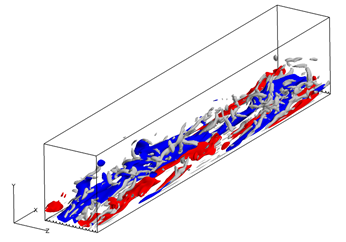Innovative Green Aircraft Technology (iGreen) : Riblet coating technology
JAXA Supercomputer System Annual Report February 2021-January 2022
Report Number: R21EDA101R01
Subject Category: Aeronautical Technology
- Responsible Representative: Mitsuru Kurita, Aeronautical Technology Directorate, Aviation Environmental Sustainability Innovation Hub
- Contact Information: Mitsuru Kurita, Aeronautical Technology Directorate, Aviation Environmental Sustainability Innovation Hub(kurita.mitsuru@jaxa.jp)
- Members: Fumitake Kuroda, Mitsuru Kurita, Monami Sasamori
Abstract
By developing a particular riblet pattern that is effective at reducing the turbulence frictional resistance, and by producing and applying an easy-to-coat method that can create an optimum riblet surface on the airframe, reduce friction drag in the turbulence boundary layer.
Reference URL
Please refer to https://www.aero.jaxa.jp/eng/research/ecat/igreen/ .
Reasons and benefits of using JAXA Supercomputer System
CFD analysis are used for developing a particular riblet pattern that is effective at reducing the turbulence frictional resistance. Huge calculation resources and costs are required for the high fidelity and quick response CFD analysis for obtaining the optimum riblet pattern. Use of JSS is indispensable for these requirements; the cost and time on the CFD analysis are drastically saved .
Achievements of the Year
We have performed a series of direct numerical simulations of a turbulent channel flow over several blade-type riblets for determining an optimal shape of the riblet. After examining the effect of the spatial resolution in the simulation, we have successfully clarified the effect of the riblet shape regarding the drag reduction rate.

Fig.1: Near-wall streaks and vortical structures in the blade-type riblet DNS. The white isosurfaces refer to positive values of the second invariant of the fluctuating velocity tensor, whereas the red and blue isocontours denote the positve and negative values of the streamwise velocity fluctuation.
Publications
N/A
Usage of JSS
Computational Information
- Process Parallelization Methods: MPI
- Thread Parallelization Methods: Automatic Parallelization
- Number of Processes: 64 – 512
- Elapsed Time per Case: 500 Hour(s)
JSS3 Resources Used
Fraction of Usage in Total Resources*1(%): 1.17
Details
Please refer to System Configuration of JSS3 for the system configuration and major specifications of JSS3.
| System Name | CPU Resources Used(Core x Hours) | Fraction of Usage*2(%) |
|---|---|---|
| TOKI-SORA | 27816177.92 | 1.35 |
| TOKI-ST | 5691.63 | 0.01 |
| TOKI-GP | 0.00 | 0.00 |
| TOKI-XM | 0.00 | 0.00 |
| TOKI-LM | 890.61 | 0.07 |
| TOKI-TST | 0.00 | 0.00 |
| TOKI-TGP | 0.00 | 0.00 |
| TOKI-TLM | 0.00 | 0.00 |
| File System Name | Storage Assigned(GiB) | Fraction of Usage*2(%) |
|---|---|---|
| /home | 9.29 | 0.01 |
| /data and /data2 | 13739.05 | 0.15 |
| /ssd | 75.00 | 0.02 |
| Archiver Name | Storage Used(TiB) | Fraction of Usage*2(%) |
|---|---|---|
| J-SPACE | 7.50 | 0.05 |
*1: Fraction of Usage in Total Resources: Weighted average of three resource types (Computing, File System, and Archiver).
*2: Fraction of Usage:Percentage of usage relative to each resource used in one year.
ISV Software Licenses Used
| ISV Software Licenses Used(Hours) | Fraction of Usage*2(%) | |
|---|---|---|
| ISV Software Licenses(Total) | 411.94 | 0.29 |
*2: Fraction of Usage:Percentage of usage relative to each resource used in one year.
JAXA Supercomputer System Annual Report February 2021-January 2022


